King Salmon "Ivory" King Salmon and Coho Salmon
|
We
provide troll-caught wild king (like that above) and coho salmon
(pictured below) taken primarily from Southeast Alaska, but also from
Washington state and northern California (see the harvest area map
below).
Pictured at right is a
king salmon fillet. Troll-caught salmon
(kings and cohos) are generally considered
the highest quality salmon for two reasons: (1) they are caught
one-at-a-time and meticulously handled, and (2) they are taken far offshore
while still in peak condition, like that pictured above (a king caught off
Seward, Alaska).
Our king salmon
include both "Red" and "Ivory" kings. "Ivory" kings,
whose flesh is white (as pictured below), are
relatively scarce. In Alaska, they occur only in Southeast where they make up just
5-8% of the catch of kings.
Our salmon are individually caught by trollers like that pictured below and
here.
These are small-boat fishermen (often the boat's crew consists of the
entire family). The fish are taken well offshore (using
flashers) while they are
still in peak condition and flavorful best. They are carefully
handled to avoid bruising and are immediately bled (which extends shelf
life), eviscerated, washed
and carefully covered with shaved ice to preserve their superb flavor
and unmatched quality. Troll-caught Alaskan salmon are
delivered to our chefs within 2 to 3 days of capture, so they are very
fresh. During the summer months, most of our salmon (and halibut and sablefish) are obtained from the
Seafood Producers
Cooperative. All of Alaska's salmon fisheries (and its halibut
and sablefish fisheries) have been certified as "sustainable" by the
Marine Stewardship Council (MSC).
In the fall, we depend on king and coho salmon headed for spawning in
rivers of Washington state's Olympic Peninsula which flow into the
Pacific Ocean.
RECIPES
Visit the Alaska Seafood
Marketing Institute
website and select "Salmon"
For illustrated instructions
on how to properly fillet a salmon, visit
Salmon
University.
|

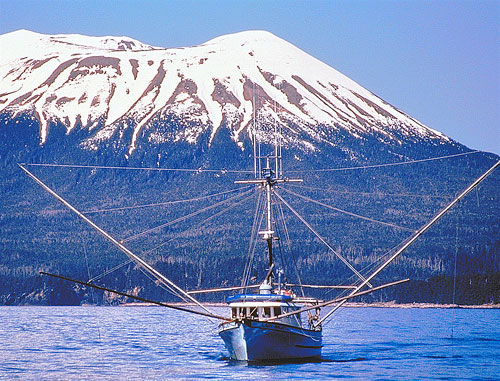
(Images
courtesy Seafood Producers Cooperative)
"Ivory" King
Salmon, Too
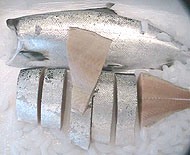

|
We provide both "Red"
and "Ivory" king salmon from
March through October. Both kings look the same from the outside,
as shown above. However, as shown to the right, the Ivory King has
luminous white flesh, that many consider superior in taste to the "red"
kings. Ivories are native to certain rivers of southeast Alaska,
Canada and Washington state. Most salmon get their typical red or
pink color from carotene in the food they eat (crustaceans such as
shrimp and krill), but white or "Ivory" kings are genetically
predisposed with an extra enzyme to process carotene rather than collect
it. Ivory king salmon tends to be milder, silkier and more buttery
in flavor than "red" kings. While the "Ivories" are difficult to
obtain, we believe they are worth the effort. |
Coho Salmon
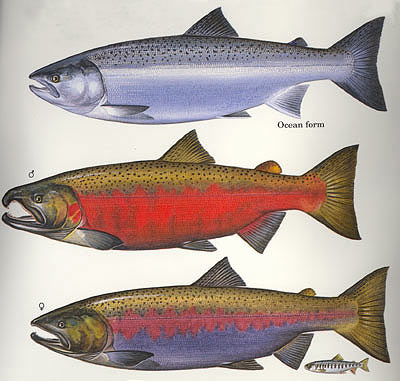
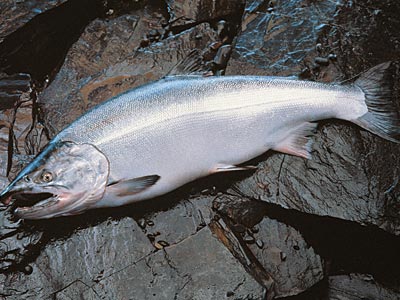
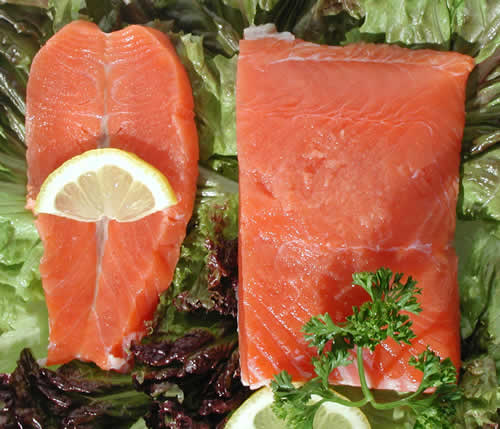 Our
Alaskan coho salmon (pictured above and to the right) are also troll-caught far at
sea while they are still in peak condition. Once Pacific salmon enter
freshwater in order to spawn their muscle tissue begins to degrade (they all
die following spawning) and their skin coloration changes dramatically from
silver to much darker patterns (both
male and female near spawning condition are shown above). As their
muscle degrades, it progressively losses quality. Our
Alaskan coho salmon (pictured above and to the right) are also troll-caught far at
sea while they are still in peak condition. Once Pacific salmon enter
freshwater in order to spawn their muscle tissue begins to degrade (they all
die following spawning) and their skin coloration changes dramatically from
silver to much darker patterns (both
male and female near spawning condition are shown above). As their
muscle degrades, it progressively losses quality.
Because troll-caught salmon
are caught at sea and before their bodies begin this transformation, they are
of better quality than salmon caught inshore by other methods. This is
because of where and how they are caught as well as how they are handled
(very carefully) from that point onward.
In contrast, lesser quality
salmon are available from
purse seine
and gillnet
fisheries. They are caught inshore and in the rivers and their muscle
tissue has already started to degrade. In contrast, the
king and coho salmon caught by trollers are called "sea-brites"
because they are still bright silver. More importantly, the salmon
harvested by traditional purse seines
are taken in large numbers. They are pumped or dumped into fishing boats' or
tenders' holds where they thrash into each other (causing damaging bruises) and where needed chilling is slowed.
In contrast, trollers catch and carefully handle their salmon one-at-a-time.
The main problem with some gillnet fisheries is the fish are often not
removed while still alive and they may have died hours before the net is
cleared. For these reasons, salmon
taken by trollers are considered to be the highest quality salmon.
|
|
Healthy Food - Pure and Natural
Wild salmon is not only
delicious, it is also ranked as the best source of Omega-3 fatty acids.
These "good" cholesterols significantly reduce the risk of coronary heart
disease, a leading cause of death. See our Health Benefits page
(below) for details. Seafood is recognized as the
healthiest source of low fat protein, and salmon, halibut and sablefish are
among the best. For information on the nutritional value of wild
Alaska seafood and its proper handling, visit the website of the
Alaska Seafood Marketing Institute. |
Smoked
King Salmon
Yukon River kings are the richest
because they contain the highest oil content (providing the extra energy
needed to reach their spawning areas some of which are 2,000 miles up-river).
In some years we can provide hot and cold-smoked Yukon River King salmon and Yukon River Fall
Chum Salmon.

Additional Pages
Sockeye Salmon
Halibut
Sablefish (Blackcod)
Striped Bass or "Rockfish"
Wreckfish
Tuna and
Swordfish
Wahoo,
Dolphin, Grouper and Snapper
Crabs, Scallops, Oysters, Mussels
and Clams
Our
Company
Retail Sales
Our Suppliers
Mission Statement
Why Buy From Us? - 10 Good
Reasons
Health Benefits of our
Products
What Seafood Should
Not be Served?
"Farm-Raised" Salmon =
"Farmed
and Dangerous"
Home

Sailfish Jim

Jim Chambers, Owner
Joe Boncore, Director of
Operations (240-483-8475)
Dan Beck, Manager of East Coast Operations
(252-202-5683)
Prime Seafood,
LLC, 9814 Kensington Parkway, Kensington, MD 20895
(Office) 301-949-7778
(Mobile) 202-330-9121
HACCP CERTIFIED
Updated 3/27/11







 Our
Alaskan coho salmon (pictured above and to the right) are also troll-caught far at
sea while they are still in peak condition. Once Pacific salmon enter
freshwater in order to spawn their muscle tissue begins to degrade (they all
die following spawning) and their skin coloration changes dramatically from
silver to much darker patterns (both
male and female near spawning condition are shown above). As their
muscle degrades, it progressively losses quality.
Our
Alaskan coho salmon (pictured above and to the right) are also troll-caught far at
sea while they are still in peak condition. Once Pacific salmon enter
freshwater in order to spawn their muscle tissue begins to degrade (they all
die following spawning) and their skin coloration changes dramatically from
silver to much darker patterns (both
male and female near spawning condition are shown above). As their
muscle degrades, it progressively losses quality.


